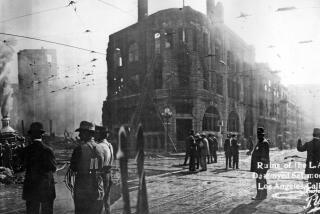The Times’ ‘Blazing Straddle’
- Share via
An experimental column in which the Los Angeles Times invites outside critics to stomp vigorously upon a Los Angeles newspaper that willfully puts cartoons on the front page of its Opinion section.
*
In the weeks leading up to today’s election in Iraq, the Los Angeles Times has distinguished itself for its breadth and depth of coverage. The correspondents on the ground have shown admirable personal courage and professional tenacity in doggedly reporting one of the most dangerous and important stories of our time.
Wouldn’t it be nice, then, if The Times completely unleashed these fine reporters and allowed them to tell us -- during the crucial period ahead -- exactly what they are and are not seeing? And even more important, what they’re thinking? All of it written in the first person from ground level?
That’s not to impugn what has been reported to date. But that reporting, like nearly all reporting in The Times, has been run through the usual sort of editorial food processor that guarantees the prevailing standard of “fair, balanced, objective stories.” You know the routine: he said/she said; yes/but; the so-called blazing straddle of “objectivity.”
As thorough as The Times’ reporting has been, it often reads as if written by acrobats in pain -- skilled professionals twisting themselves and their copy into knots as they strain to “balance” what they are actually seeing with the sometimes fantasy-based spin of both Iraqi and U.S. officialdom.
We need go no further than an otherwise compelling Times report out of Baghdad a few weeks ago. It began with the assertion that although the election process was, indeed, going ahead, its “planners” still faced what were called “the nuts and bolts of holding a credible vote.” Insurgents gunning down election workers and candidates, the latter campaigning only clandestinely, the polling stations still a secret, car bombs killing dozens a week -- these are mere nuts and bolts? Maybe to the U.S. Embassy -- but for the rest of us? Puh-leeze.
The Times, in an unsigned editorial a few days ago, spoke much more forthrightly of the same surreal circumstances surrounding this election, saying it could all prove to be a “disappointing farce” that could eventually “fuel a civil war.”
In other words, in accord with the odd strictures of American journalism, Times editorial writers, sitting in offices thousands of miles away from Baghdad, are permitted to directly tell us the unvarnished truth -- at least as they see it -- but the front-line reporters risking their lives still have to balance their reports with what is often little more than official propaganda. How’d we get in that fix?
Somewhere along the line, American newspapers jumbled and polluted the concept of being objective. Objectivity, maybe better called truth-telling, should be the cherished goal of all reporters and editors. But objectivity is a process, not a final product. Objective reporters must make a good-faith effort to call ‘em as they see ‘em, offering firm evidence for what they assert. Objectivity should not, however, be an end product, a formulaic, filed-off article whose fundamental truths are watered down and often distorted with an artificial balance of nontruths.
The latter is what New York University media critic Jay Rosen calls “the contraption” of American newspaper journalism -- a decidedly obsolete device that warrants the trash bin. The expectations, tastes and desires of the mass media audience are rapidly shifting under the feet of American newspapers, and The Times, along with other major dailies, must urgently accommodate this change. One way to start is to respect the ability of the readers to judge for themselves what to conclude and no longer spoon-feed them the bland, precooked and predigested “balanced” vocabulary of newspaperese.
Among the many Times dispatches from Iraq this past month, there was one tasty first-person report that boldly stood out from the lot. Detailing the frustration of her colleagues, the Times reporter wrote vividly of the “short leash” they find themselves on, unable to travel almost anywhere in Iraq without being transported by one set of belligerents in the war (i.e., the U.S. and British embassies). Just to get a standard briefing, reporters are obliged to spend hours in an armored and impenetrable bubble as helicopter gunships ferry them across the country. It was a wonderful, unvarnished piece, free of equivocation, never pretending to give “both sides” but ably conveying a convincing picture of the enormous obstacles in reporting just about anything out of today’s Iraq. What a refreshing read.
The Times should have the courage to run more of these first-person pieces full of personal observation, analysis and interpretation from a staff of reporters more than able to provide them. I suspect the resulting product would be contradictory -- different reporters seeing different realities. So what?
Believe it or not, readers are more than smart enough to figure out who and what to trust or not trust. Anyway, there is no single objective truth about anything. And the more The Times at least implicitly continues to argue there is, the less confidence, the less investment, an increasingly media-savvy readership will have in the product.
More to Read
Get the L.A. Times Politics newsletter
Deeply reported insights into legislation, politics and policy from Sacramento, Washington and beyond. In your inbox three times per week.
You may occasionally receive promotional content from the Los Angeles Times.










